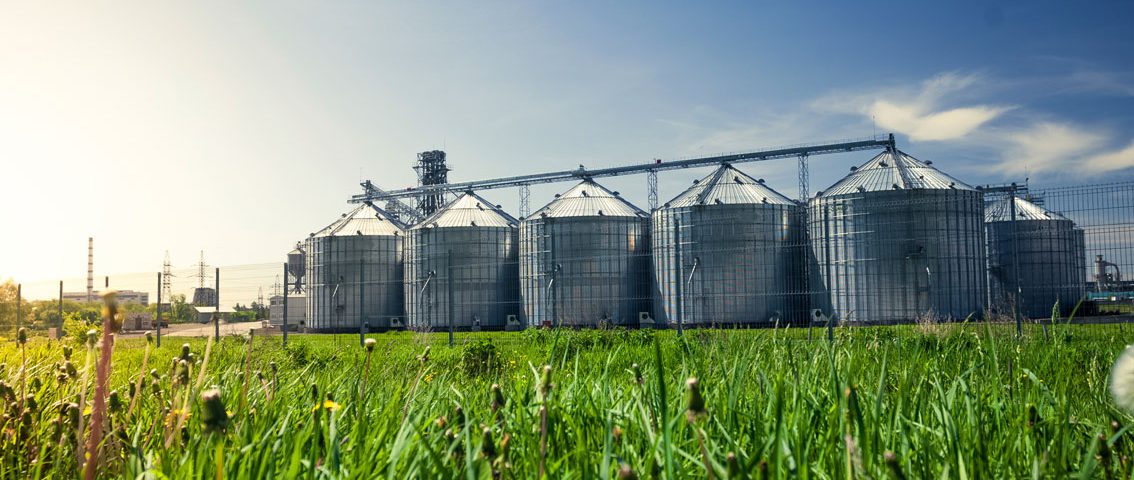“We are giving more power back to the farmer,” Travis Florey told the Ambassador of Kenya when they met last September at the World Trade Center Arkansas. “We’re helping them build their own economy.”
As they sat around a table with each other, Ambassador of Kenya to the U.S. Robinson Njeru Githae was not the only diplomat intently listening. Ambassador Githae’s trade attaché, Abdirizak Musa was present and as Florey spoke, he held the attention of diplomats from Canada and Cote d’Ivoire. Delon Chan, consul and trade commissioner of the Canadian Consulate General in Dallas and Mamadou Kone, special advisor to the Delegate General of Cote d’Ivoire were listening intently with the others for ways to bring IntelliFarms technology to their home countries and improve the lives of their citizens. Chan was taking notes diligently as he – and the others – were thinking of ways to create new opportunities for their country’s farmers.
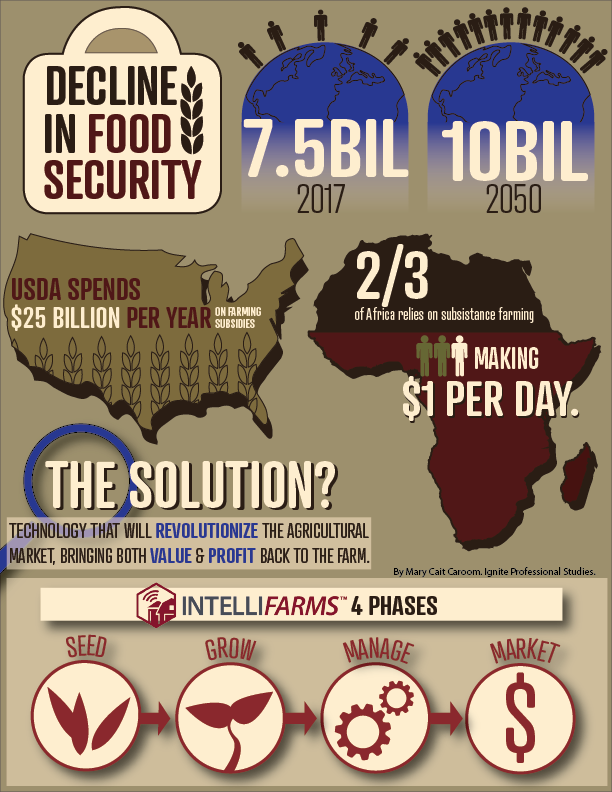 Florey is the vice president of the strategic division for IntelliFarms, a World Trade Center Arkansas Client with nearly 100 employees and a simple driving principal: bring value and profit back to the farm by helping farmers grow for a purpose. They consider themselves at home on the “Silicon Prairie” where their company strives to bring powerful innovations and technology to the American farmer.
Florey is the vice president of the strategic division for IntelliFarms, a World Trade Center Arkansas Client with nearly 100 employees and a simple driving principal: bring value and profit back to the farm by helping farmers grow for a purpose. They consider themselves at home on the “Silicon Prairie” where their company strives to bring powerful innovations and technology to the American farmer.
But their vision is not limited to America’s borders. With the realization that they are successfully bringing smart farming and sustainability to the American farm has come a sense of enthusiasm – even urgency – to use their technology to solve the world’s food shortage issues.
Africa may hold the answer
Take sub-Saharan Africa for example, where more than 750 million people – nearly two-thirds of the continent’s population – rely on subsistence farming as their main source of food and income, which is usually less than $1 per day.
Compared to other places like India, China and South America where billions of people live on small-scale farms, only sub-Saharan Africa shows a decline in food security and agricultural productivity per capita and an increase in undernourishment since the 1990s.
“Food security is without question the largest issue facing the world today,” Florey says. “With an estimated population growth from 7.5 billion to more than 9 billion by 2050 we have a daunting task of feeding those mouths before us. The only continent that has the arable land available to meet the food needs of this growth is Africa – development must start now.”
Florey says that agricultural production within the country for crops like rice is not big enough to meet their need. “They have to go to another country and buy it for a premium.”
Further, they lack the processing facilities in their own country which forces them to sell crops in an unrefined state.
“These countries are dependent on products being processed elsewhere,” he said. “When you can’t create production facilities in your own country, all the economic development benefits go into another one.”
The Solution
Florey says the solution to this is to reduce the cost and increase the profitability of doing business, to control your own market and create jobs and develop local economies.
If there was ever a sentence that captured the idea “easier said than done” – that was it.
We all know its easy to diagnose an issue, but much harder to prescribe a solution that actually works. But this is where IntelliFarms shines. They don’t just talk the talk, but they put their money (or more accurately, their technology) where their mouth is. The beauty of this is that their technology can be applied in both developing countries and developed countries – like the U.S. and Canada. And both will reap enormous benefits.
Putting Florey’s solution into an agricultural context, IntelliFarms helps farmers grow for a purpose from seed to storage to market with their technology. Ultimately, the tools give them what they need to increase their quality and profitability and create a network of buyers and sellers in their market – usually the home country.
IntelliFarms can accomplish this through four phases, or “seasons” if you will: seed, grow, manage and market. Their solutions can help a farmer choose the perfect seed, grow while making precise, data driven calculations, manage the storage of their harvest, and market their crop to the highest bidder.
Seed

What do we mean when we say “the perfect” seed? Well imagine a farmer in Arkansas wants to plant soy. Every farmer’s goal is to produce a successful crop, but how can a farmer know which type of seed will be the most sucessful? What factors are at stake? Perhaps there is a larger concentration of clay in the fields than normal. Maybe we are dealing with an outbreak of pests for the past three years that could be harmful to the crop. Will his herbicide choices have any effect? Will the irrigation system be sufficient?
These types of questions and more are what farmers wrestle with when determining what seed to plant. There will be a lot of guesswork, research and consulting with other farmers but our farmer can only do so much before planting must begin. Our farmer is a farmer after all, so consider the myriad other responsibilities that demand attention and require a full day’s work that begins before dawn and ends late at night.
Considering this and their mission to empower farmers, IntelliFarms created an incredible system that eliminates guesswork and combines unbiased field trial data from millions of studies and thousands of seed varieties and places it into a single ranking system. The YieldFax system allows the farmer to choose seed based on his yield or purpose and assists farmers in picking the best seed variety for their regions.
A farmer can then input all those questions that he wrestled with before as parameters into the system: geographic region, soil type, maturity, herbicide choices, pest resistance and more. YieldFax will then pull a list of varieties that best meet the farmer’s needs. In choosing their preferred variety of seed, the farmer takes the first step to increase their farm’s productivity. The next step is to plant and grow.
Grow
Before the seed is even planted, farmers can use the FieldDataManager system to determine the best planting times so they don’t suffer yield loss from the start. The FieldDataManager system is a weather station and soil probe network that collects real-time weather and soil data up to a two mile radius. The system is wireless and can measure things like rainfall within 1/100th of an inch, solar and UV rays, wind speed and gusts, soil moisture and can even accurately project crop maturity.
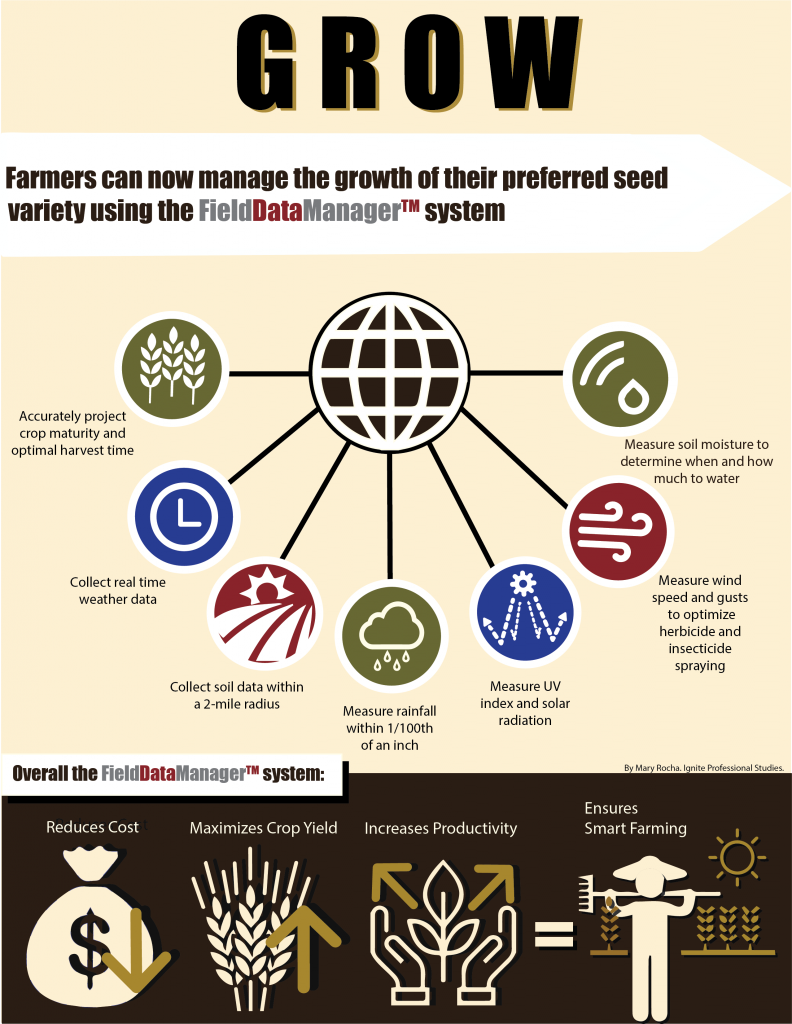
All of this data helps the farmer know when and how to make decisions – taking the guess work out of it and replacing it with specific steps based on precise measurements. Wind speed and direction tells him how to spray herbicide and insecticide. Projecting crop maturity tells a farmer when the optimal time for harvesting begins. Measuring soil moisture tells him when and how much to water – which is an invaluable tool to conserve water where it is scarce.
“Kenya is a water deficient country,” said Ambassador Githae. “To give an example, rice farmers just flood their fields. But if you are able to monitor the moisture content, you do not need to use all that water. So we can save lots of money on this. And Arkansas is a leading state in this area and therefore we hope to benefit from the experience and research that has been done.”
This experience and research leads to companies like Intellifarms consolidating this data and putting it into the hands of a farmer who can access it from anywhere he has an internet connection. FieldDataManager truly realizes the idea of a “silicon prairie.”
Florey puts it simply: “We provide farmers with data that challenges the status quo.”
The status quo being practices and tendencies that have been handed down for generations that may inhibit a farmer’s ability to reduce cost, increase productivity and maximize crop yield. It’s not that these practices are without merit but Intellifarms’ technology develops and evolves these practices, allowing the farmer to use them when appropriate to maximize efficiency and quality.
When the harvest time comes, FieldDataManager will alert him when quality peaks so he can capture the crop at its best. He will have a crop grown from seed that thrived in his soil and was nurtured with the perfect amount of resources. He will have saved money, conserved resources, and harvest with the confidence that his crop has reached its full potential.
But how can he preserve this quality after harvest?
Manage
That’s where BinManager comes in. Once a farmer harvests his grain, it will be stored. BinManager allows a farmer to reduce post-harvest loss by maximizing storage efficiency. With the BinManager system, a farmer can monitor the condition of his stored grain from anywhere in the world just as he could view it in the fields as it grew with FieldDataManager.
 “BinManager allows a farmer to dry grain based on moisture content and ambient conditions outside,” Florey said.
“BinManager allows a farmer to dry grain based on moisture content and ambient conditions outside,” Florey said.
“We can use it to build a custom program that reduces energy costs, reduces the amount of spoilage and improves the quality of the grain.”

IntelliFarms’ FieldDataManager System is a network of solar powered soil probes and weather stations that covers a 2-mile radius. FieldDataManager and BinManager can be accessed and controlled anywhere in the world with an internet connection
With this system a farmer can measure the moisture content of his grain.
He can plug parameters into the system based on his own preferences and the system itself operates the fans and heaters automatically to push only “productive” air onto the stored grain. It can even prevent insects from swarming and spoiling the grain.
In fact, the technology is so effective at extending storage life and preventing spoilage that for more than three years the Intellifarms team monitored a single batch of soybeans. When this farmer finally pulled his beans to sell, the beans retained the exact same quality the day they were stored, according to the farmer.
This incredible system empowers him to preserve the quality of his grain until supply is low and demand is high. Then he can find the highest paying buyer.
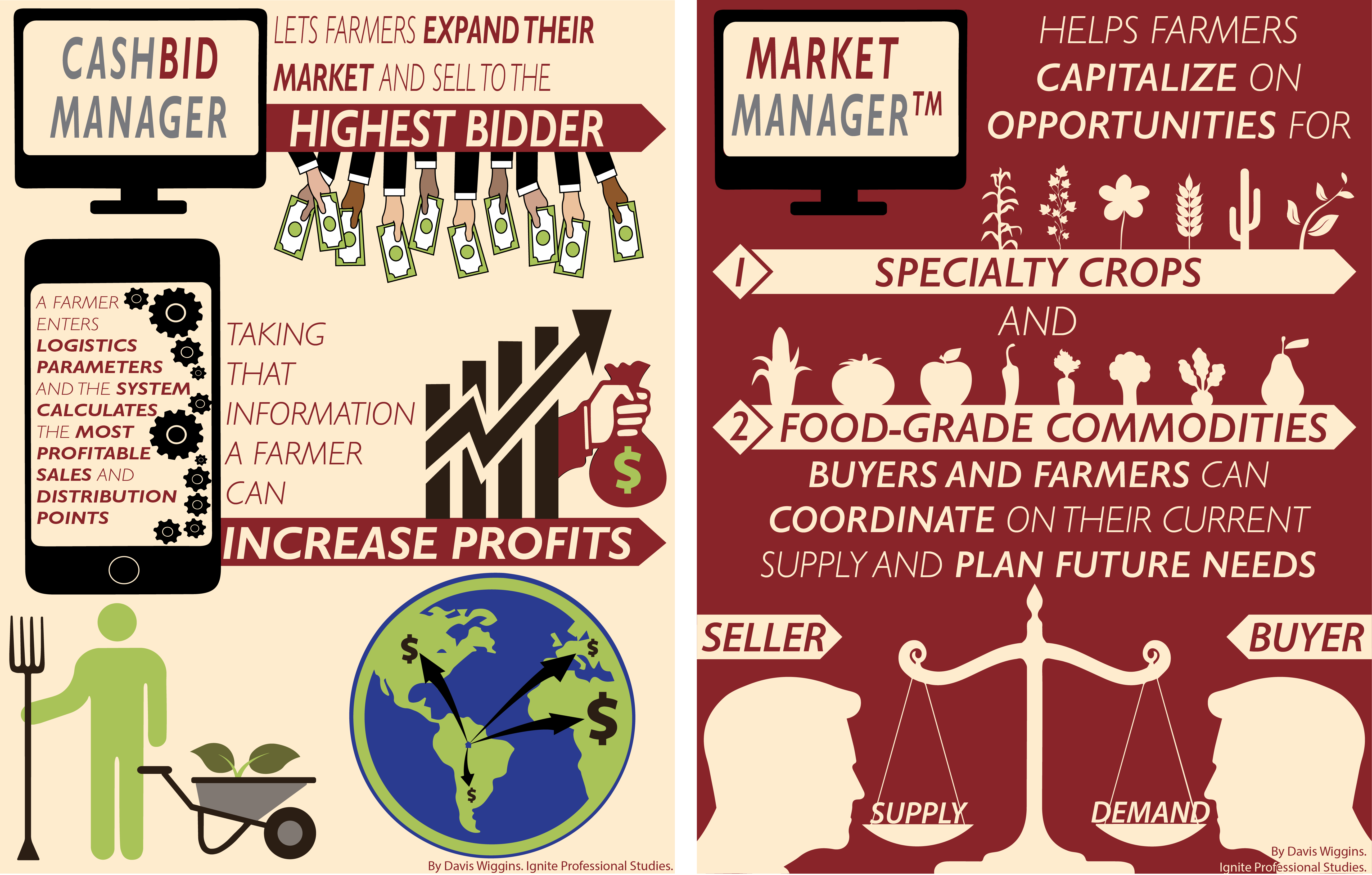
Market
When a farmer is determining the right time to sell, he can utilize Intellifarms’ CashBidManager to expand his market access and sell his grain to the highest bidder.
“A farmer can put in his logistics parameters – basically the cost per mile of delivery,” Florey said. “The system then makes a calculation on where this farmer’s most profitable sales and distributions points are.”
Taking that information a farmer can get more bang for his buck and increase his profits. Even if he has favored relationships with his buyers, he can mark those points and will be given updates and daily reports for these markets.
On the other side of the coin, is where supply meets demand. MarketManager helps the farmer capitalize on opportunities for specialty crops and food-grade commodities. They can coordinate with buyers on their current supply, negotiate contracts and plan future supply needs.
Okay. So there is a lot to take in. There’s been a lot of talk about supply and demand. Florey says IntelliFarms can help farmers build their own economy? So what does it look like when all these solutions come together? Where do our diplomats, Africa, developing countries and developed countries fit into this story?
To learn the answers to these questions, subscribe to our newsletter, like us on Facebook or follow us on Twitter as we release the conclusion to our story on Monday.
Bringing it all together
So let’s bring it all together. IntelliFarms calls this suite of solutions “SureTrack.” YieldFax helps a farmer identify which seed has been a top performer, based on his growing environment, no matter if he is growing for yield or for a purpose.
FieldDataManager monitors real-time weather and soil conditions of his fields so a farmer can make data-driven decisions, which simultaneously reduces costs (like irrigation and fertilizer), grows his farms value and increases his profits.
BinManager helps eliminates the farmer’s post-harvest lost and increases energy and storage efficiency. This reduces energy costs associated with storing and drying and allows him to wait until supply is low and demand in high to increases his profits.
CashBidManager and MarketManager bring supplier and buyer together, allowing a farmer to identify the highest bidding buyer interested in his grains and identify and create other market opportunities – which increases his profits.
If it’s not clear already where this is going, read the final three words in the previous three paragraphs.
Yet, more than an a simple increase in profits, what’s really happening with the SureTrack platform is that the power to influence supply and demand is being put into the hands of the farmer.
If the World Trade Center Arkansas can assist IntelliFarms in exporting this technology to developing countries, then their agriculture sectors will be able to evolve and develop their own micro economies to fit the needs of the greater market.
“If you look at our suite of solutions holistically,” Florey says, “we are assisting farmers in increasing production and improving product quality. Our market solutions are physically allowing farmers to create and increase demand. So they have the tools to increase their supply and the tools to increase demand. That demand is going to increase the premiums farmers’ receive. The quality of the product acquired by large processors will improve and that will put more money into the farmer’s pockets.”
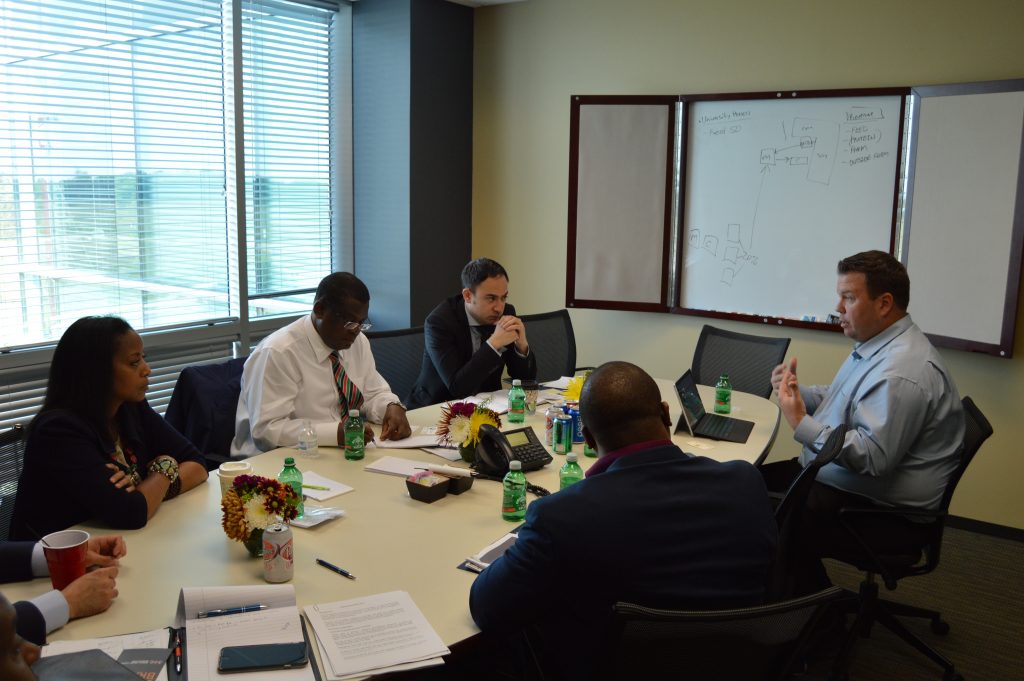
Travis Florey (far right) explains the SureTrack platform to special advisor Mamadou Kone (front), Canadian trade consul Delon Chan (center) and Ambassador Githae (left of Chan) and Denise Thomas (left of Ambassador) at the World Trade Center Arkansas.
Developing Countries
The solutions that impact the seed, growing and storage phases have huge implications for developing countries like Cote d’Ivoire and Kenya that face the risk of food shortages. SureTrack allows them to increase their crop yield and with the implementation of mechanized harvesting they could be well on their way to solving their hunger problems.
“[For this technology], all would depend on the affordability for the small farmer and for the small villagers,” special advisor Kone says. “Because in Africa it’s the small farmers that really make up the numbers. For the big farmers it’s no problem, but for the small farmers, we have to find a way to make it affordable, to finance it and to train them,” he said.
Kone says that Africa is largely concerned with mechanizing agriculture and mechanizing the processing system right now.
“In Cote d’Ivoire 40 percent of our GDP is agriculture,” he said. “We have more farmers than the U.S. – but in total the U.S. is producing more because of the mechanized agriculture system. One person can farm hundreds of acres instead of just a few. In Cote d’Ivoire we have the small farmer that has several acres but it takes all his time and energy to farm it.”
When you take Kone’s explanation into consideration, it becomes apparent that only certain groups in African countries will be able to benefit from smart farming technologies at first. The vast majority won’t be able to afford it until mechanization is widespread and their increased profits allow them to afford the technology.
However, this does not destroy all hope of getting SureTrack to Africa soon – it only needs a foot in the door to be able to demonstrate its vast benefits. Once many farmers see how much it helps a single farmer, we can expect them to seek out smart farming technology more enthusiastically. Eventually the revenue of the agriculture sector will increase.
“By increasing the revenue of the agriculture sector,” Florey said, “A country can then drive up its taxable revenue and its government can provide services to the entire country which will improve the standard of living. Our goal with Kenya is to assist them in developing a strategy to implement technology into agriculture that will improve rural profitability and increase employment in the agricultural sector.”
When Ambassador Githae and Trade Attaché Musa returned to the Embassy in Washington D.C., they shared this new information with their contacts in Nairobi.
“The next step is to form a team of experts from the Agriculture and Food Authority [of Kenya] to identify where there is a need,” Musa said.
Once they identify areas where a need for this technology exists, they will gauge the interest of Kenyan farmers and assess the affordability of this technology.
“Our farmers are very smart,” Musa said. “Once they know that it’s good for them, they’ll buy. So once we find where a need exists, we want to bring IntelliFarms to Kenya. We hope to have boots on the ground before December. Then we can take this to the next level.”
First World Application
So SureTrack can help with food shortage issues, but what about countries that are already developed? Like the U.S and Canada?
“If there’s anything that affects our [post-harvest] loss, it is the cold weather,” Delon Chan said speaking about Canada’s issues with grain storage. “It’s not as strong as an issue in developing countries but there should be an opportunity for research collaboration.”
“We’re reaching out to contacts and we want to introduce IntelliFarms to Canadian grain storage experts on the Canadian Wheat Board Grain Storage Research Center and to the Research Chair of Stored Grain Ecosystems,” he said.
This type of research and collaboration will help identify where the greatest needs for this technology are and how best to apply it in a developed country’s agriculture sector to decrease post-harvest loss. This collaboration may even pave the way for even more advanced smart farming systems.
“There are other companies doing what IntelliFarms does – some more successful than others but it’s a really cool way to approach agriculture – to have these agriculture companies who are disrupting the industry,” Chan said.
Chan is right about disruption. If one looks at the big picture they will see how IntelliFarms can take things one step further: they can help eliminate the farmer’s risk of not having a crop that pays for itself – a role traditionally fulfilled by government subsidies. They make farming profitable.
Subsidies protect a farmer from two things: Mother Nature and market fluctuations – the market fluctuations can force a farmer to sell at a loss or be stuck with his grain without a buyer. No one can overcome Mother Nature but IntelliFarms’ technology ensures that a farmer can always put up a good fight against her. Furthermore, a farmer can always find the highest bidder and store their grain until they have a buyer knowing the quality of the crop they have grown.
Now, take one moment and imagine if everyone were on this system. In theory, farmers could have such a dramatic effect on the supply side that they could influence demand to make prices meet their profit goals – eliminating their need for subsidies, according to Florey.
“Our number one goal is to create a profitable economy for farmers,” Florey said. “The only way to do that is to increase production and decrease post-harvest lost.”
For developing countries this is huge – it means governments can feed more of their people and can spare revenue for other needs like education and infrastructure. Furthermore, when yield is maximized by farmers in developed countries, they can export surpluses to these developing countries. These countries will have their food needs met until they can develop their agriculture enough to completely sustain their populations, ideally using this same smart farming technology.
The next step for the World Trade Center Arkansas is to collaborate with the teams from Canada, Kenya and Cote d’Ivoire and arrange a trade mission to bring IntelliFarms to these countries. Then IntelliFarms, the Center – and by extension the University of Arkansas – can lay the groundwork for an effective approach to solving hunger problems in undeveloped countries that have perplexed the world for decades.
The mission of the World Trade Center Arkansas is to grow trade and increase Arkansas exports by connecting Arkansas businesses to the world through international trade services. For more information and valuable updates, please follow the Center on Facebook and Twitter, or subscribe to the World Trade Center Arkansas newsletter.
The World Trade Center Arkansas would like to thank Bentonville Public Schools students Tanner Burgess, Blake Belts, Davis Wiggins, Mary Cait Caroom and Mary Rocha of the Ignite Professional Studies Program for creating the infographics.




